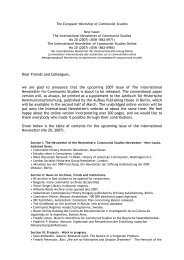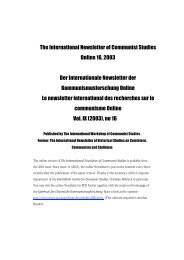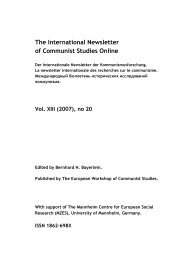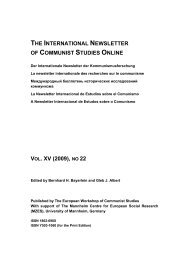VOL. XVI (2010), NO 23 - The International Newsletter of Communist ...
VOL. XVI (2010), NO 23 - The International Newsletter of Communist ...
VOL. XVI (2010), NO 23 - The International Newsletter of Communist ...
Sie wollen auch ein ePaper? Erhöhen Sie die Reichweite Ihrer Titel.
YUMPU macht aus Druck-PDFs automatisch weboptimierte ePaper, die Google liebt.
<strong>The</strong> <strong>International</strong> <strong>Newsletter</strong> <strong>of</strong> <strong>Communist</strong> Studies Online <strong>XVI</strong> (<strong>2010</strong>), no. <strong>23</strong> 148<br />
In China, apart from the problem <strong>of</strong> dialect in places like Shanghai, native place identities<br />
stood in the way <strong>of</strong> the CCP’s efforts to build up a labour movement along class lines.<br />
Notwithstanding these difficulties, the author explains, native place identities, however,<br />
ultimately gave the working masses a sense <strong>of</strong> organizational bonding, which served the<br />
cause <strong>of</strong> class politics. This suggests, as Smith points out, that the traditional suspicion <strong>of</strong> the<br />
Bolsheviks as well as the CCP towards the parochialism <strong>of</strong> native-place identity is not<br />
tenable, and it is also not correct to suggest that identity awareness necessarily runs against<br />
class mobilization. In Chapter Two, this discussion assumes an interesting theoretical angle,<br />
since the author raises the question that, as the impact <strong>of</strong> capitalist modernity led to<br />
assertion <strong>of</strong> individuality among the workers in Russia and China, the most important aspect<br />
<strong>of</strong> which was the demand for recognition <strong>of</strong> the ‘self’ as a noun (vide Charles Taylor) and<br />
their dignity, was it then antithetical to class solidarity? <strong>The</strong> author convincingly argues that,<br />
although compared with China, in Russia the spirit <strong>of</strong> individualism was stronger, in both the<br />
cases “the intrinsic worth <strong>of</strong> the individual became a potent means <strong>of</strong> political critique that<br />
empowered people to come together to fight for social and political change” (p.110). This<br />
then contests the somewhat standard understanding that claims <strong>of</strong> individuality and<br />
collectivism being mutually exclusive. In other words, modernity gave them a new sense <strong>of</strong><br />
identity in the form <strong>of</strong> individuation, which ultimately served the cause <strong>of</strong> class solidarity.<br />
Further, in a subsequent Chapter the author addresses another contentious issue that has<br />
always been a subject <strong>of</strong> debate, namely, the class vs. nation question. While it is generally<br />
true that in Russia the pulls <strong>of</strong> class overshadowed those <strong>of</strong> the nation, in China it was vice<br />
versa; the author shows, with reference to suitable examples, that in Russia national and<br />
class identities were mutually reinforcing despite the apparent primacy <strong>of</strong> the class factor. As<br />
Smith explains, the rhetoric <strong>of</strong> so-called patriotism <strong>of</strong> the Russian elite was challenged by the<br />
nationalism <strong>of</strong> the suffering toilers, which eventually dovetailed with the class aims <strong>of</strong> their<br />
struggle. It thus became a battle <strong>of</strong> true vs. false nationalism, the class struggle <strong>of</strong> the<br />
workers being considered as an expression <strong>of</strong> authentic nationalism. Similarly, in the case <strong>of</strong><br />
China, radical anti-imperialism ultimately became a class question, as manifest, for instance,<br />
in the workers’ protests against Japanese- and British-owned companies in Shanghai (p.<br />
190).<br />
In the concluding Chapter the author comes out with the bold formulation that it would be a<br />
misstatement to view the two Revolutions simply as instances <strong>of</strong> worker-peasant alliance.<br />
Many other factors like the army and the party acted as overdeterminants. Besides,<br />
communist ideology, while introducing a challengingly new notion <strong>of</strong> modernity, which<br />
impinged on identities and loyalties, also thrived on tradition and focused on values that<br />
highlighted the importance <strong>of</strong> the social collective or recuperated certain elements <strong>of</strong> the<br />
traditional male-dominated society, despite talks <strong>of</strong> women’s emancipation.<br />
This is a refreshingly new analysis, full <strong>of</strong> deep insights, based on new historical data. <strong>The</strong><br />
findings <strong>of</strong> the author would motivate any serious historian <strong>of</strong> the Russian or the Chinese<br />
Revolution to look more carefully into their complexities. <strong>The</strong> interpretations, which are<br />
provocative as well as debatable, provide food for thought to the discerning reader.














